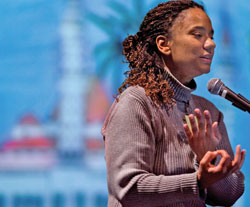Cartoons help give African children a voice

Animator Cilia Sawadogo describes her leadership of animation workshops in Nairobi.
Photo by andrew dobrowolskyj
Cilia Sawadogo, a professor at the Mel Hoppenheim School of Cinema, took part in a UNESCO project called Africa Animated! that has really taken off. She talked about it in a lecture Jan. 25 at the Musée d’art contemporain de Montréal.
In 2004, she was invited to teach at a five-week animation workshop held at the Zanzibar International Film Festival and in Nairobi, Kenya. Trainees from Kenya, Tanzania, and Uganda were given support toward animating original children’s stories.
The films were such a hit at the Durban International Film Festival that DIFF offered to host the UNESCO workshop the following year with the University of KwaZulu-Natal’s Centre for Creative Arts, also in Durban.
This ongoing project is good news for the industry. Despite an abundance of talent, African animation faces many challenges. Production studios, equipment and financing are in short supply and distribution is limited.
The media adds to the problem by being myopic about the potential for animation in the marketplace. Since most animators can’t support themselves, they often finish projects between other jobs or leave the country to work in the West.
But as Sawadogo pointed out, it’s not just Africa that has these difficulties. “There is a similar reality in Quebec as well, and we share many of the same problems,” she said.
Despite the obstacles, African directors continue to produce innovative animated films that are winning over international audiences.
During her lecture, Sawadogo talked about the success of The Legend of the Sky Kingdom. This 2003 full-length production from Zimbabwe was in the top five chosen out of 1,300 entries at the World Animation Festival.
Produced in the capital city of Harare on a minimal budget, the film pioneered a new technique dubbed “junkmation” where characters and sets are made from discarded items like kitchen utensils and car parts.
Participants in Africa Anim-ated! also experimented with a variety of techniques that included claymation, cut-outs, 3D objects and computer-generated images. Their original works show an emerging African style filled with bold colours, infectious music and a gentle sense of humour.
Animation is seen as a powerful tool not only to educate but also to give African children a voice. Many of the films screened at the lecture addressed social issues pertinent to Africa.
Masha tells the story of a young girl about to be sold into marriage by her father while Kizito introduces us to a young boy who isn’t allowed to go to school.
Both children from Shiku’s Song and Wahu want to be better students but don’t have time for anything but housework and working in the fields. Itchy Pitchy taught the importance of personal hygiene and The Fulfilling Competition talked about good nutrition.
Sawadogo also showed her own hand-drawn short film La Femme Mariée à Trois Hommes based on a popular legend to demonstrate how the oral traditions of African culture are particularly well suited to animation.
The future for African animation is looking brighter thanks to this program.
“It’s helping to define a style with an African signature but we need to keep developing the political will to support African animation,” Sawadogo said.
In the meantime. Africans can start enjoying the movies. A television station in Nairobi, KTN, has started regularly airing the films.